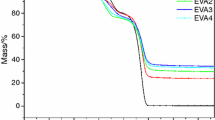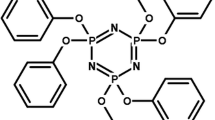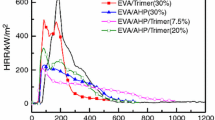Abstract
In order to prepare a synergetic flame retardant, the magnesium hydroxide (MH) and hexaphenoxycyclotriphosphazene (HPCTP) were blended with ethylene–vinyl acetate copolymer (EVA). The EVA–MH–HPCTP composite materials were characterized by various tests including Fourier transform infrared spectroscopy, X-ray diffractometer and scanning electron microscopy (SEM). The SEM images indicated that the compatibility of EVA–MH–HPCTP composite materials was significantly promoted due to the bridging effect of HPCTP. Therefore, the EVA–MH–HPCTP composite materials possessed better processability which was evidenced by the melt flow rate tests. Comparing to the traditional addition dosage (over 50%) of MH in previous reports, the EVA–MH–HPCTP composite materials showed significant flame-retardant efficiency even when the dosage of MH was lowered to 20 parts per hundred resins. The experimental results suggest that the prepared EVA–MH–HPCTP composite material may be a potential candidate in various industrial applications due to its excellent flame retardant.








Similar content being viewed by others
Abbreviations
- EVA:
-
Ethylene–vinyl acetate
- MH:
-
Hydroxide magnesium
- HPCTP:
-
Phenoxycyclophosphazene
- LOI:
-
Limiting oxygen index
- MFR:
-
Melt flow rate
- FTIR:
-
Fourier transform infrared
- XRD:
-
X-ray diffraction
- SEM:
-
Scanning electron microscope
- phr:
-
Parts per hundred resins
References
Zhang S et al (2018) Synergistic effects of modified hydrotalcite on improving the fire resistance of ethylene vinyl acetate containing intumescent flame retardants. Polym Compos 39(2):522–528
Czanderna AW, Pern FJ (1996) Encapsulation of PV modules using ethylene vinyl acetate copolymer as a pottant: a critical review. Sol Energy Mater Sol Cells 43(2):101–181
Alexandre M et al (2001) Preparation and properties of layered silicate nanocomposites based on ethylene vinyl acetate copolymers. Macromol Rapid Commun 22(8):643–646
Liu J et al (2018) Synthesis of Co3(HPO4)2(OH)2 nanosheets and its synergistic effect with intumescent flame retardants in ethylene–vinyl acetate copolymer. Polym Compos 39(1):238–246
de Oliveira MCC et al (2018) The causes and effects of degradation of encapsulant ethylene vinyl acetate copolymer (EVA) in crystalline silicon photovoltaic modules: a review. Renew Sustain Energy Rev 81:2299–2317
Gui H et al (2007) Flame retardant synergism of rubber and Mg(OH)2 in EVA composites. Polymer 48(9):2537–2541
Liu H et al (2009) The effects of irradiation cross-linking on the thermal degradation and flame-retardant properties of the HDPE/EVA/magnesium hydroxide composites. Radiat Phys Chem 78(11):922–926
Zhou X et al (2017) Synthesis and characterization of two-component acidic ion intercalated layered double hydroxide and its use as a nanoflame-retardant in ethylene vinyl acetate copolymer (EVA). RSC Adv 7(84):53064–53075
Alaee M et al (2003) An overview of commercially used brominated flame retardants, their applications, their use patterns in different countries/regions and possible modes of release. Environ Int 29(6):683–689
Bjermo H et al (2017) Serum levels of brominated flame retardants (BFRs: PBDE, HBCD) and influence of dietary factors in a population-based study on Swedish adults. Chemosphere 167:485–491
Larsson K et al (2018) Brominated flame retardants and organophosphate esters in preschool dust and children’s hand wipes. Environ Sci Technol 52(8):4878–4888
Shi Z et al (2018) Legacy and emerging brominated flame retardants in China: a review on food and human milk contamination, human dietary exposure and risk assessment. Chemosphere 198:522–536
Casetta M et al (2018) Key role of magnesium hydroxide surface treatment in the flame retardancy of glass fiber reinforced polyamide 6. Polym Degrad Stab 148:95–103
Liu J et al (2018) Interaction between magnesium hydroxide and microencapsulated red phosphorus in flame-retarded high-impact polystyrene composite. Fire Mater 1(1):1–9
Sain M et al (2004) Flame retardant and mechanical properties of natural fibre–PP composites containing magnesium hydroxide. Polym Degrad Stab 83(2):363–367
Qiu L et al (2003) Preparation and characterization of Mg(OH)2 nanoparticles and flame-retardant property of its nanocomposites with EVA. Compos Struct 62(3):391–395
Laoutid F et al (2006) Study of hydromagnesite and magnesium hydroxide based fire retardant systems for ethylene–vinyl acetate containing organo-modified montmorillonite. Polym Degrad Stab 91(12):3074–3082
Du L, Qu B, Xu Z (2006) Flammability characteristics and synergistic effect of hydrotalcite with microencapsulated red phosphorus in halogen-free flame retardant EVA composite. Polym Degrad Stab 91(5):995–1001
Ye L, Wu Q, Qu B (2009) Synergistic effects and mechanism of multiwalled carbon nanotubes with magnesium hydroxide in halogen-free flame retardant EVA/MH/MWNT nanocomposites. Polym Degrad Stab 94(5):751–756
Li Z, Qu B (2003) Flammability characterization and synergistic effects of expandable graphite with magnesium hydroxide in halogen-free flame-retardant EVA blends. Polym Degrad Stab 81(3):401–408
Lorenzetti A et al (2017) Expandable graphite in polyurethane foams: the effect of expansion volume and intercalants on flame retardancy. J Appl Polym Sci 134(31):45173
Fu M, Qu B (2004) Synergistic flame retardant mechanism of fumed silica in ethylene–vinyl acetate/magnesium hydroxide blends. Polym Degrad Stab 85(1):633–639
Yu Z-L et al (2018) Fire-retardant and thermally insulating phenolic-silica aerogels. Angew Chem Int Ed 57(17):4538–4542
Savas LA et al (2017) Effect of microcapsulated red phosphorus on flame retardant, thermal and mechanical properties of thermoplastic polyurethane composites filled with huntite&hydromagnesite mineral. Polym Degrad Stab 135:121–129
Shen L et al (2017) The enhanced compatibility and flame retarding ability of UHMWPE-MH composites by adding phenoxycyclophosphazene (HPCTP). Polym Bull 74(9):3639–3655
Shen L et al (2018) A new strategy to produce low-density polyethylene (LDPE)-based composites simultaneously with high flame retardancy and high mechanical properties. Appl Surf Sci 437:75–81
Gu J et al (2017) Highly thermally conductive flame-retardant epoxy nanocomposites with reduced ignitability and excellent electrical conductivities. Compos Sci Technol 139:83–89
Riva A et al (2003) Fire retardant mechanism in intumescent ethylene vinyl acetate compositions. Polym Degrad Stab 82(2):341–346
Cao T et al (2015) Fabrication and origin of new flame retarding bismaleimide resin system with low dielectric constant and loss based on microencapsulated hexaphenoxycyclotriphosphazene in low phosphorus content. Polym Degrad Stab 121:157–170
Yan H et al (2014) Synthesis and characterization of novel organic magnesium salt flame retardant. Mater Lett 134:210–213
Lai S-M et al (2003) Comparative study of maleated polyolefins as compatibilizers for polyethylene/wood flour composites. J Appl Polym Sci 87(3):487–496
Huo S et al (2018) Synergistic effect between a novel triazine-based flame retardant and DOPO/HPCP on epoxy resin. Polym Adv Technol 1(1):1–10
Aaronson AM, Bright DA (1996) Oligomeric phosphate esters as flame retardants. Phosphorus Sulfur Silicon Relat Elem 109(1–4):83–86
Qian L, Feng F, Tang S (2014) Bi-phase flame-retardant effect of hexa-phenoxy-cyclotriphosphazene on rigid polyurethane foams containing expandable graphite. Polymer 55(1):95–101
Acknowledgements
Financial support of National Natural Science Foundation of China (Nos. 21506195, 21775138, 51578509) and Zhejiang Provincial Natural Science Foundation of China (Nos. LQ17E080011, LQ16B060001) is highly appreciated.
Author information
Authors and Affiliations
Corresponding author
Rights and permissions
About this article
Cite this article
Shen, L., Shao, C., Li, R. et al. Preparation and characterization of ethylene–vinyl acetate copolymer (EVA)–magnesium hydroxide (MH)–hexaphenoxycyclotriphosphazene (HPCTP) composite flame-retardant materials. Polym. Bull. 76, 2399–2410 (2019). https://doi.org/10.1007/s00289-018-2500-1
Received:
Revised:
Accepted:
Published:
Issue Date:
DOI: https://doi.org/10.1007/s00289-018-2500-1




